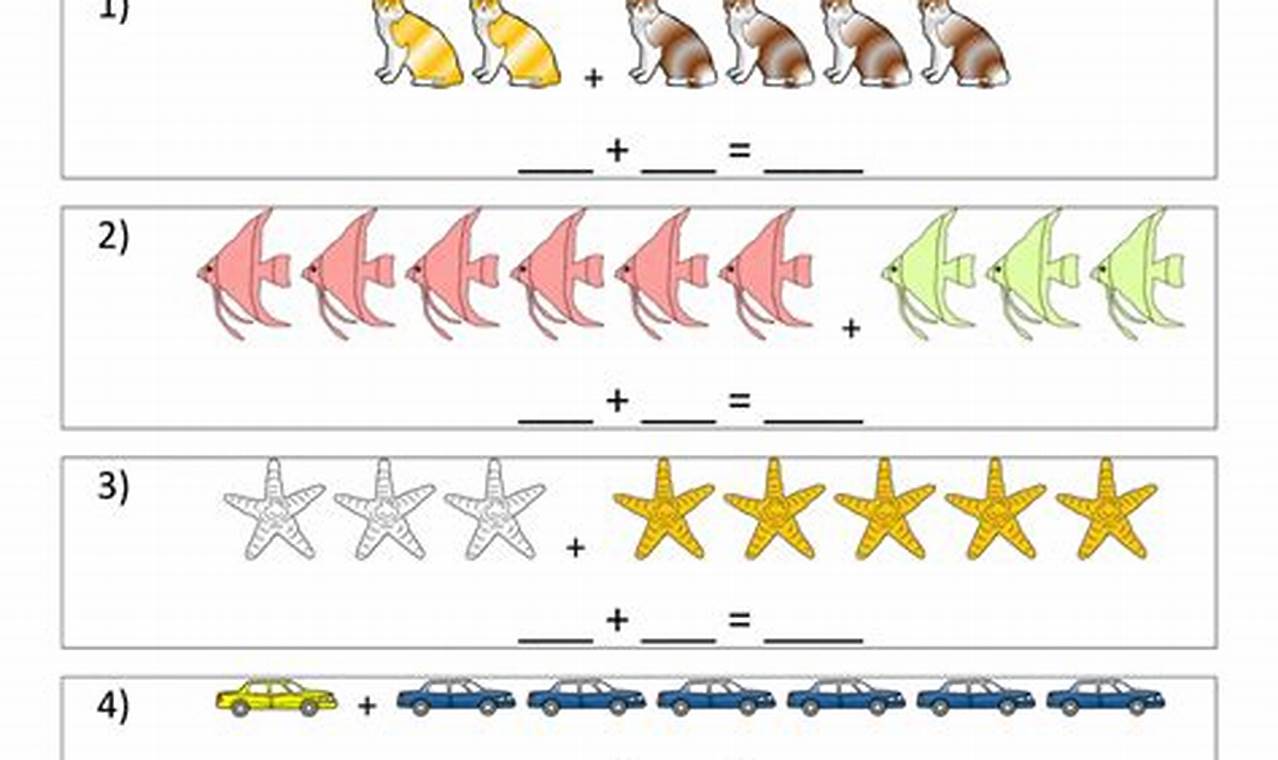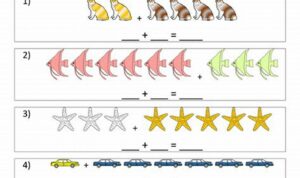Basic addition worksheets are educational tools designed to help students practice and improve their addition skills. These worksheets typically consist of a series of simple addition problems, arranged in an organized and progressive manner. Each problem typically involves adding two or more single-digit numbers, and the worksheets may vary in difficulty level depending on the intended grade level.
Basic addition worksheets are an essential part of early mathematics education, providing a structured and systematic approach to developing foundational math skills. They help students build a strong understanding of addition concepts, improve their number sense, and develop fluency in solving addition problems. Regular practice with basic addition worksheets can also enhance problem-solving abilities, critical thinking skills, and overall mathematical confidence.
These worksheets can be used in various educational settings, including classrooms, homeschooling environments, and as part of individualized learning programs. They can be incorporated into math lessons, used for independent practice, or assigned as homework to reinforce classroom instruction.
Basic Addition Worksheets
Basic addition worksheets are crucial educational tools for developing foundational math skills. These worksheets provide:
- Systematic practice: Worksheets offer a structured approach to practicing addition, allowing students to reinforce concepts and build fluency.
- Progressive learning: Problems are arranged in a logical sequence, gradually increasing in difficulty to challenge students and promote growth.
- Assessment tool: Worksheets can be used to assess students’ understanding of addition and identify areas for improvement.
- Independent learning: Students can work through worksheets at their own pace, fostering self-directed learning and problem-solving skills.
Overall, basic addition worksheets play a vital role in early mathematics education by providing a supportive environment for students to develop a strong foundation in addition and enhance their overall mathematical abilities.
Systematic practice
Systematic practice is a key component of effective learning, and basic addition worksheets provide a structured and methodical approach to practicing addition skills. By repeatedly working through addition problems, students can reinforce their understanding of the concepts involved and develop greater fluency in solving addition problems.
-
Component 1: Repetition and Reinforcement
Worksheets provide multiple opportunities for students to practice addition problems, which helps to reinforce their understanding of the concepts and procedures involved. Repetition allows students to strengthen the neural pathways associated with addition, making it easier to recall and apply the skills in different situations. -
Component 2: Gradual Progression
Worksheets are typically designed with a gradual progression of difficulty, starting with simple problems and gradually introducing more challenging ones. This allows students to build confidence and mastery as they progress through the worksheets, reducing frustration and promoting a sense of accomplishment. -
Component 3: Independent Learning
Worksheets can be used for independent practice, allowing students to work at their own pace and reinforce their learning outside of the classroom setting. This promotes self-directed learning and encourages students to take ownership of their learning process.
Overall, the systematic practice provided by basic addition worksheets is essential for developing fluency and mastery of addition skills. By providing repeated exposure to addition problems in a structured and progressive manner, worksheets help students build a strong foundation for future mathematical learning.
Progressive learning
Progressive learning is a fundamental component of basic addition worksheets, as it allows students to develop a deep understanding of addition concepts and skills. By arranging problems in a logical sequence and gradually increasing their difficulty, worksheets provide a structured learning path that challenges students and promotes growth.
The logical sequencing of problems ensures that students build a strong foundation before moving on to more complex concepts. Thisapproach allows students to master each step of the learning process, reducing frustration and fostering a sense of accomplishment. As students progress through the worksheets, they encounter problems that require them to apply their understanding in new and challenging ways, promoting critical thinking and problem-solving skills.
In real-life scenarios, progressive learning is essential for students to develop mathematical fluency and apply their addition skills effectively. For example, a student who is learning to add two-digit numbers needs to first master adding single-digit numbers. By practicing with basic addition worksheets that follow a progressive learning approach, students can build the necessary skills and confidence to tackle more complex addition problems in the future.
Understanding the connection between progressive learning and basic addition worksheets is crucial for educators and parents who want to support students’ mathematical development. By providing worksheets that follow a logical sequence and gradually increase in difficulty, they can create a learning environment that fosters growth and empowers students to become confident and capable mathematicians.
FAQs on Basic Addition Worksheets
This section addresses common questions and misconceptions related to basic addition worksheets, providing concise and informative answers to support understanding and effective use of these educational tools.
Question 1: Why are basic addition worksheets important for students?
Basic addition worksheets play a vital role in developing foundational math skills. They provide structured practice, reinforce concepts, and promote fluency in addition, which is essential for higher-level mathematical learning.
Question 2: How can I use basic addition worksheets effectively in the classroom or at home?
To use basic addition worksheets effectively, start by assessing students’ current abilities and choosing worksheets that are appropriately challenging. Provide clear instructions, encourage students to show their work, and offer support and feedback as needed.
Question 3: What is the best way to introduce basic addition worksheets to young learners?
When introducing basic addition worksheets to young learners, start with simple problems involving small numbers. Use concrete materials like blocks or counters to represent numbers and demonstrate addition concepts visually.
Question 4: How often should students practice with basic addition worksheets?
Regular practice is key for mastery. Aim for at least 15-20 minutes of practice with basic addition worksheets each day. Adjust the frequency and duration based on students’ individual needs and progress.
Question 5: What are some common mistakes students make when working with basic addition worksheets?
Common mistakes include miscounting, incorrect number combinations, and errors in carrying or borrowing. Monitor students’ work carefully and provide timely feedback to address these errors.
Question 6: How can I make basic addition worksheets more engaging for students?
To make basic addition worksheets more engaging, incorporate visual aids, puzzles, games, or real-life scenarios. Encourage students to create their own addition problems and challenge themselves with more complex problems.
Summary: Basic addition worksheets are valuable tools for building a strong foundation in mathematics. By understanding their importance, using them effectively, and addressing common challenges, educators and parents can support students’ learning and foster a positive attitude towards math.
Transition to the next article section: To further enhance students’ addition skills, consider exploring interactive online games, math manipulatives, and problem-solving activities that reinforce addition concepts in a fun and engaging way.
Tips for Using Basic Addition Worksheets Effectively
To maximize the benefits of basic addition worksheets, consider implementing these effective tips:
Tip 1: Start with the Basics
Before introducing worksheets, ensure students have a solid grasp of basic addition concepts. Use manipulatives, number lines, or mental math exercises to reinforce these foundational skills.
Tip 2: Choose Age-Appropriate Worksheets
Select worksheets that align with students’ current skill level. Worksheets that are too easy can lead to boredom, while those that are too challenging can cause frustration.
Tip 3: Provide Clear Instructions
Before students begin working on worksheets, take time to explain the instructions thoroughly. Ensure they understand the concepts being tested and the steps involved in solving the problems.
Tip 4: Encourage Problem-Solving Strategies
Worksheets should not only focus on rote memorization. Encourage students to develop their problem-solving skills by asking them to explain their approaches and justify their answers.
Tip 5: Offer Timely Feedback
Provide regular feedback on students’ work to reinforce correct methods and identify areas for improvement. Timely feedback helps students stay on track and avoid developing misconceptions.
Tip 6: Make it Engaging
To maintain students’ interest, incorporate variety into worksheet practice. Use different formats, such as puzzles, games, or real-world scenarios, to make learning more enjoyable.
Tip 7: Use Worksheets as a Diagnostic Tool
Worksheets can provide valuable insights into students’ strengths and weaknesses. Analyze their performance to identify areas where they need additional support or enrichment.
Tip 8: Encourage Self-Assessment
Encourage students to self-assess their work by checking their answers and identifying any errors. Self-assessment promotes metacognition and helps students become more independent learners.
Summary: By implementing these tips, educators can harness the full potential of basic addition worksheets to enhance students’ mathematical skills, build confidence, and foster a positive attitude towards learning.
Transition to the article’s conclusion: Worksheets are a valuable tool, but they should be used as part of a comprehensive and engaging mathematics program that emphasizes conceptual understanding, problem-solving, and real-world applications.
Conclusion
In conclusion, basic addition worksheets play a critical role in developing foundational math skills and promoting mathematical fluency. Through systematic practice, progressive learning, and targeted instruction, these worksheets provide a supportive environment for students to build a strong understanding of addition concepts and enhance their problem-solving abilities.
It is imperative for educators to recognize the significance of basic addition worksheets and incorporate them effectively into their teaching practices. By embracing the tips outlined in this article, educators can transform worksheets into powerful tools that engage students, foster conceptual understanding, and cultivate a positive attitude towards mathematics. As we continue to explore innovative approaches to teaching and learning, basic addition worksheets will undoubtedly remain a valuable resource for educators and students alike.


